您好,登錄后才能下訂單哦!
您好,登錄后才能下訂單哦!
這篇文章主要介紹JS中this在各個場景下指向的示例分析,文中介紹的非常詳細,具有一定的參考價值,感興趣的小伙伴們一定要看完!
1. this 的奧秘
很多時候, JS 中的 this 對于咱們的初學者很容易產生困惑不解。 this 的功能很強大,但需要一定付出才能慢慢理解它。
對Java、PHP或其他標準語言來看,this 表示類方法中當前對象的實例。大多數情況下,this 不能在方法之外使用,這樣就比較不會造成混淆。
在J要中情況就有所不同: this表示函數的當前執行上下文,JS 中函數調用主要有以下幾種方式:
函數調用: alert('Hello World!')
方法調用: console.log('Hello World!')
構造函數: new RegExp('\\d')
隱式調用: alert.call(undefined, 'Hello World!')
每種調用類型以自己的方式定義上下文,所以就很容易產生混淆。
此外,嚴格模式也會影響執行上下文。
理解this關鍵是要清楚的知道函數調用及其如何影響上下文。
本文主要說明函數的調用方式及如何影響 this,并且說明執行上下文的常見陷阱。
在開始之前,先知道幾個術語:
調用函數正在執行創建函數體的代碼,或者只是調用函數。 例如,parseInt函數調用是parseInt('15')。
函數調用:執行構成函數主體的代碼:例如,parseInt函數調用是parseInt('15')。
調用的上下文:指 this 在函數體內的值。 例如,map.set('key', 'value')的調用上下文是 map。
函數的作用域:是在函數體中可訪問的變量、對象和函數的集合。
2.函數調用
當一個表達式為函數接著一個(,一些用逗號分隔的參數以及一個)時,函數調用被執行,例如parseInt('18')。
函數調用表達式不能是屬性方式的調用,如 obj.myFunc(),這種是創建一個方法調用。再如 [1,5].join(',')不是函數調用,而是方法調用,這種區別需要記住哈,很重要滴。
函數調用的一個簡單示例:
function hello(name) {
return 'Hello ' + name + '!';
}
// 函數調用
const message = hello('World');
console.log(message); // => 'Hello World!'hello('World')是函數調用: hello表達式等價于一個函數,跟在它后面的是一對括號以及'World'參數。
一個更高級的例子是IIFE(立即調用的函數表達式)
const message = (function(name) {
return 'Hello ' + name + '!';
})('World');
console.log(message) // => 'Hello World!'IIFE也是一個函數調用:第一對圓括號(function(name) {...})是一個表達式,它的計算結果是一個函數對象,后面跟著一對圓括號,圓括號的參數是“World”。
2.1. 在函數調用中的this
this 在函數調用中是一個全局對象
局對象由執行環境決定。在瀏覽器中,this是 window 對象。
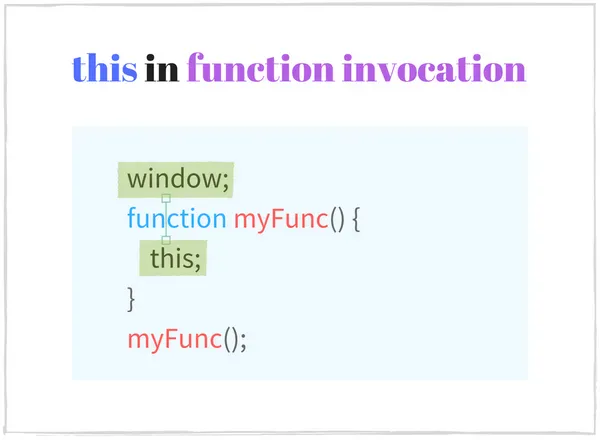
在函數調用中,執行上下文是全局對象。
再來看看下面函數中的上下文又是什么鬼:
function sum(a, b) {
console.log(this === window); // => true
this.myNumber = 20; // 將'myNumber'屬性添加到全局對象
return a + b;
}
// sum() is invoked as a function
// sum() 中的 `this` 是一個全局對象(window)
sum(15, 16); // => 31
window.myNumber; // => 20在調用sum(15,16)時,JS 自動將this設置為全局對象,在瀏覽器中該對象是window。
當this在任何函數作用域(最頂層作用域:全局執行上下文)之外使用,this 表示 window 對象
console.log(this === window); // => true this.myString = 'Hello World!'; console.log(window.myString); // => 'Hello World!' <!-- In an html file --> <script type="text/javascript"> console.log(this === window); // => true </script>
2.2 嚴格模式下的函數調用 this 又是什么樣的
this 在嚴格模式下的函數調用中為 undefined嚴格模式是在 ECMAScript 5.1中引入的,它提供了更好的安全性和更強的錯誤檢查。
要啟用嚴格模式,函數頭部寫入use strict 即可。
啟用后,嚴格模式會影響執行上下文,this 在常規函數調用中值為undefined。 與上述情況2.1相反,執行上下文不再是全局對象。
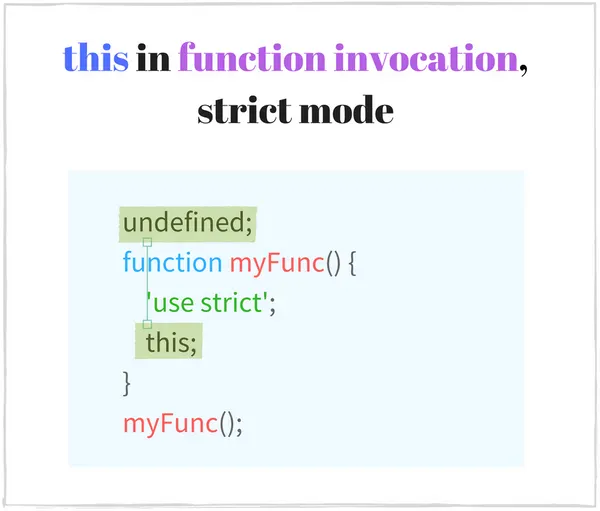
嚴格模式函數調用示例:
function multiply(a, b) {
'use strict'; // 啟用嚴格模式
console.log(this === undefined); // => true
return a * b;
}
multiply(2, 5); // => 10當multiply(2,5)作為函數調用時,this是undefined。
嚴格模式不僅在當前作用域中有效,在內部作用域中也是有效的(對于在內部聲明的所有函數):
function execute() {
'use strict'; // 開啟嚴格模式
function concat(str1, str2) {
// 嚴格模式仍然有效
console.log(this === undefined); // => true
return str1 + str2;
}
// concat() 在嚴格模式下作為函數調用
// this in concat() is undefined
concat('Hello', ' World!'); // => "Hello World!"
}
execute();'use strict'被插入到執行體的頂部,在其作用域內啟用嚴格模式。 因為函數concat是在執行的作用域中聲明的,所以它繼承了嚴格模式。
單個JS文件可能包含嚴格和非嚴格模式。 因此,對于相同的調用類型,可以在單個腳本中具有不同的上下文行為:
function nonStrictSum(a, b) {
// 非嚴格模式
console.log(this === window); // => true
return a + b;
}
function strictSum(a, b) {
'use strict';
// 啟用嚴格模式
console.log(this === undefined); // => true
return a + b;
}
nonStrictSum(5, 6); // => 11
strictSum(8, 12); // => 202.3 陷阱:this 在內部函數中的時候
函數調用的一個常見陷阱是,認為this在內部函數中的情況與外部函數中的情況相同。
正確地說,內部函數的上下文只依賴于它的調用類型,而不依賴于外部函數的上下文。
要將 this 設置為所需的值,可以通過 .call()或.apply()修改內部函數的上下文或使用.bind()創建綁定函數。
下面的例子是計算兩個數的和:
function nonStrictSum(a, b) {
// 非嚴格模式
console.log(this === window); // => true
return a + b;
}
function strictSum(a, b) {
'use strict';
// 啟用嚴格模式
console.log(this === undefined); // => true
return a + b;
}
nonStrictSum(5, 6); // => 11
strictSum(8, 12); // => 20sum()是對象上的方法調用,所以sum中的上下文是numbers對象。calculate函數是在sum中定義的,你可能希望在calculate()中this也表示number對象。
calculate()是一個函數調用(不是方法調用),它將this作為全局對象window(非嚴格模下)。即使外部函數sum將上下文作為number對象,它在calculate里面沒有影響。
sum()的調用結果是NaN,不是預期的結果5 + 10 = 15,這都是因為沒有正確調用calculate。
為了解決這個問題,calculate函數中上下文應該與 sum 中的一樣,以便可以訪問numberA和numberB屬性。
一種解決方案是通過調用calculator.call(this)手動將calculate上下文更改為所需的上下文。
const numbers = {
numberA: 5,
numberB: 10,
sum: function() {
console.log(this === numbers); // => true
function calculate() {
console.log(this === numbers); // => true
return this.numberA + this.numberB;
}
// 使用 .call() 方法修改上下文
return calculate.call(this);
}
};
numbers.sum(); // => 15call(this)像往常一樣執行calculate函數,但 call 會把上下文修改為指定為第一個參數的值。
現在this.numberA + this.numberB相當于numbers.numberA + numbers.numberB。 該函數返回預期結果5 + 10 = 15。
另一種就是使用箭頭函數
const numbers = {
numberA: 5,
numberB: 10,
sum: function() {
console.log(this === numbers); // => true
const calculate = () => {
console.log(this === numbers); // => true
return this.numberA + this.numberB;
}
return calculate();
}
};
numbers.sum(); // => 153.方法調用
方法是存儲在對象屬性中的函數。例如
const myObject = {
// helloFunction 是一個方法
helloFunction: function() {
return 'Hello World!';
}
};
const message = myObject.helloFunction();helloFunction是myObject的一個方法,要調用該方法,可以這樣子調用 :myObject.helloFunction。
當一個表達式以屬性訪問的形式執行時,執行的是方法調用,它相當于以個函數接著(,一組用逗號分隔的參數以及)。
利用前面的例子,myObject.helloFunction()是對象myObject上的一個helloFunction的方法調用。[1, 2].join(',') 或/\s/.test('beautiful world')也被認為是方法調用。
區分函數調用和方法調用非常重要,因為它們是不同的類型。主要區別在于方法調用需要一個屬性訪問器形式來調用函數(obj.myFunc()或obj['myFunc']()),而函數調用不需要(myFunc())。
['Hello', 'World'].join(', '); // 方法調用
({ ten: function() { return 10; } }).ten(); // 方法調用
const obj = {};
obj.myFunction = function() {
return new Date().toString();
};
obj.myFunction(); // 方法調用
const otherFunction = obj.myFunction;
otherFunction(); // 函數調用
parseFloat('16.60'); // 函數調用
isNaN(0); // 函數調用理解函數調用和方法調用之間的區別有助于正確識別上下文。
3.1 方法調用中 this 是腫么樣
在方法調用中,this是擁有這個方法的對象當調用對象上的方法時,this就變成了對象本身。

創建一個對象,該對象有一個遞增數字的方法
const calc = {
num: 0,
increment: function() {
console.log(this === calc); // => true
this.num += 1;
return this.num;
}
};
// method invocation. this is calc
calc.increment(); // => 1
calc.increment(); // => 2調用calc.increment()使increment函數的上下文成為calc對象。所以使用this.num來增加num屬性是有效的。
再來看看另一個例子。JS對象從原型繼承一個方法,當在對象上調用繼承的方法時,調用的上下文仍然是對象本身
const myDog = Object.create({
sayName: function() {
console.log(this === myDog); // => true
return this.name;
}
});
myDog.name = 'Milo';
// 方法調用 this 指向 myDog
myDog.sayName(); // => 'Milo'Object.create()創建一個新對象myDog,并根據第一個參數設置其原型。myDog對象繼承sayName方法。
執行myDog. sayname()時,myDog是調用的上下文。
在EC6 class 語法中,方法調用上下文也是實例本身
class Planet {
constructor(name) {
this.name = name;
}
getName() {
console.log(this === earth); // => true
return this.name;
}
}
var earth = new Planet('Earth');
// method invocation. the context is earth
earth.getName(); // => 'Earth'3.2 陷阱:將方法與其對象分離
方法可以從對象中提取到一個單獨的變量const alone = myObj.myMethod。當方法單獨調用時,與原始對象alone()分離,你可能認為當前的this就是定義方法的對象myObject。
如果方法在沒有對象的情況下調用,那么函數調用就會發生,此時的this指向全局對象window嚴格模式下是undefined。
下面的示例定義了Animal構造函數并創建了它的一個實例:myCat。然后setTimout()在1秒后打印myCat對象信息
function Animal(type, legs) {
this.type = type;
this.legs = legs;
this.logInfo = function() {
console.log(this === myCat); // => false
console.log('The ' + this.type + ' has ' + this.legs + ' legs');
}
}
const myCat = new Animal('Cat', 4);
// The undefined has undefined legs
setTimeout(myCat.logInfo, 1000);你可能認為setTimout調用myCat.loginfo()時,它應該打印關于myCat對象的信息。
不幸的是,方法在作為參數傳遞時與對象是分離,setTimout(myCat.logInfo)以下情況是等效的:
setTimout(myCat.logInfo); // 等價于 const extractedLogInfo = myCat.logInfo; setTimout(extractedLogInfo);
將分離的logInfo作為函數調用時,this是全局 window,所以對象信息沒有正確地打印。
函數可以使用.bind()方法與對象綁定,就可以解決 this 指向的問題。
function Animal(type, legs) {
this.type = type;
this.legs = legs;
this.logInfo = function() {
console.log(this === myCat); // => true
console.log('The ' + this.type + ' has ' + this.legs + ' legs');
};
}
const myCat = new Animal('Cat', 4);
// logs "The Cat has 4 legs"
setTimeout(myCat.logInfo.bind(myCat), 1000);myCat.logInfo.bind(myCat)返回一個新函數,它的執行方式與logInfo完全相同,但是此時的 this 指向 myCat,即使在函數調用中也是如此。
另一種解決方案是將logInfo()方法定義為一個箭頭函數:
function Animal(type, legs) {
this.type = type;
this.legs = legs;
this.logInfo = () => {
console.log(this === myCat); // => true
console.log('The ' + this.type + ' has ' + this.legs + ' legs');
};
}
const myCat = new Animal('Cat', 4);
// logs "The Cat has 4 legs"
setTimeout(myCat.logInfo, 1000);4. 構造函數調用
當new關鍵詞緊接著函數對象,(,一組逗號分隔的參數以及)時被調用,執行的是構造函數調用如new RegExp('\\d')。
聲明了一個Country函數,并且將它作為一個構造函數調用:
function Country(name, traveled) {
this.name = name ? name : 'United Kingdom';
this.traveled = Boolean(traveled);
}
Country.prototype.travel = function() {
this.traveled = true;
};
// 構造函數調用
const france = new Country('France', false);
// 構造函數調用
const unitedKingdom = new Country;
france.travel(); // Travel to Francenew Country('France', false)是Country函數的構造函數調用。它的執行結果是一個name屬性為'France'的新的對象。 如果這個構造函數調用時不需要參數,那么括號可以省略:new Country。
從ES6開始,JS 允許用class關鍵詞來定義構造函數
class City {
constructor(name, traveled) {
this.name = name;
this.traveled = false;
}
travel() {
this.traveled = true;
}
}
// Constructor invocation
const paris = new City('Paris', false);
paris.travel();new City('Paris')是構造函數調用。這個對象的初始化由這個類中一個特殊的方法constructor來處理。其中,this指向新創建的對象。
構造函數創建了一個新的空的對象,它從構造函數的原型繼承了屬性。構造函數的作用就是去初始化這個對象。 可能你已經知道了,在這種類型的調用中,上下文指向新創建的實例。
當屬性訪問myObject.myFunction前面有一個new關鍵詞時,JS會執行構造函數調用而不是原來的方法調用。
例如new myObject.myFunction():它相當于先用屬性訪問把方法提取出來extractedFunction = myObject.myFunction,然后利用把它作為構造函數創建一個新的對象: new extractedFunction()。
4.1. 構造函數中的 this
在構造函數調用中 this 指向新創建的對象
構造函數調用的上下文是新創建的對象。它利用構造函數的參數初始化新的對象,設定屬性的初始值,添加事件處理函數等等。
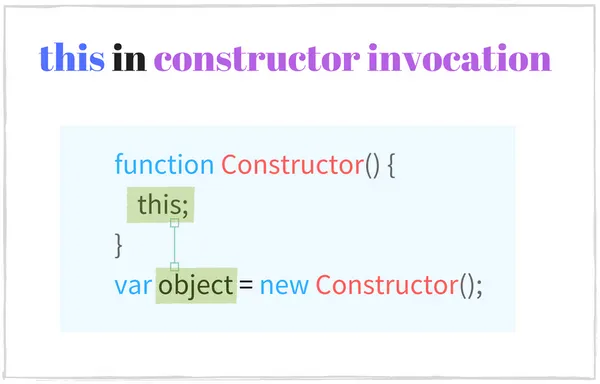
來看看下面示例中的上下文
function Foo () {
console.log(this instanceof Foo); // => true
this.property = 'Default Value';
}
// Constructor invocation
const fooInstance = new Foo();
fooInstance.property; // => 'Default Value'new Foo() 正在進行構造函數調用,其中上下文是fooInstance。 在Foo內部初始化對象:this.property被賦值為默認值。
同樣的情況在用class語法(從ES6起)時也會發生,唯一的區別是初始化在constructor方法中進行:
class Bar {
constructor() {
console.log(this instanceof Bar); // => true
this.property = 'Default Value';
}
}
// Constructor invocation
const barInstance = new Bar();
barInstance.property; // => 'Default Value'4.2. 陷阱: 忘了使用 new
有些JS函數不是只在作為構造函數調用的時候才創建新的對象,作為函數調用時也會,例如RegExp:
var reg1 = new RegExp('\\w+');
var reg2 = RegExp('\\w+');
reg1 instanceof RegExp; // => true
reg2 instanceof RegExp; // => true
reg1.source === reg2.source; // => true當執行的 new RegExp('\\w+')和RegExp('\\w+')時,JS 會創建等價的正則表達式對象。
使用函數調用來創建對象存在一個潛在的問題(不包括工廠模式),因為一些構造函數可能會忽略在缺少new關鍵字時初始化對象的邏輯。
下面的例子說明了這個問題:
function Vehicle(type, wheelsCount) {
this.type = type;
this.wheelsCount = wheelsCount;
return this;
}
// 忘記使用 new
const car = Vehicle('Car', 4);
car.type; // => 'Car'
car.wheelsCount // => 4
car === window // => trueVehicle是一個在上下文對象上設置type和wheelsCount屬性的函數。
當執行Vehicle('Car', 4)時,返回一個對象Car,它具有正確的屬性:Car.type 為 Car和Car.wheelsCount 為4,你可能認為它很適合創建和初始化新對象。
然而,在函數調用中,this是window對象 ,因此 Vehicle('Car',4)在 window 對象上設置屬性。 顯然這是錯誤,它并沒有創建新對象。
當你希望調用構造函數時,確保你使用了new操作符:
function Vehicle(type, wheelsCount) {
if (!(this instanceof Vehicle)) {
throw Error('Error: Incorrect invocation');
}
this.type = type;
this.wheelsCount = wheelsCount;
return this;
}
// Constructor invocation
const car = new Vehicle('Car', 4);
car.type // => 'Car'
car.wheelsCount // => 4
car instanceof Vehicle // => true
// Function invocation. Throws an error.
const brokenCar = Vehicle('Broken Car', 3);new Vehicle('Car',4) 運行正常:創建并初始化一個新對象,因為構造函數調用中時使用了new關鍵字。
在構造函數里添加了一個驗證this instanceof Vehicle來確保執行的上下文是正確的對象類型。如果this不是Vehicle,那么就會報錯。這樣,如果執行Vehicle('Broken Car', 3)(沒有new),我們會得到一個異常:Error: Incorrect invocation。
5. 隱式調用
使用myFun.call()或myFun.apply()方法調用函數時,執行的是隱式調用。
JS中的函數是第一類對象,這意味著函數就是對象,對象的類型為Function。從函數對象的方法列表中,.call()和.apply()用于調用具有可配置上下文的函數。
方法 .call(thisArg[, arg1[, arg2[, ...]]])將接受的第一個參數thisArg作為調用時的上下文,arg1, arg2, ...這些則作為參數傳入被調用的函數。
方法.apply(thisArg, [args])將接受的第一個參數thisArg作為調用時的上下文,并且接受另一個類似數組的對象[arg1, arg2, ...] 作為被調用函數的參數傳入。
下面是隱式調用的例子
function increment(number) {
return ++number;
}
increment.call(undefined, 10); // => 11
increment.apply(undefined, [10]); // => 11increment.call()和increment.apply()都用參數10調用了這個自增函數。
兩者的區別是.call()接受一組參數,例如myFunction.call(thisValue, 'value1', 'value2')。而.apply()接受的一組參數必須是一個類似數組的對象,例如myFunction.apply(thisValue, ['value1', 'value2'])。
5.1. 隱式調用中的this
在隱式調用.call()或.apply()中,this是第一個參數
很明顯,在隱式調用中,this作為第一個參數傳遞給.call()或.apply()。
var rabbit = { name: 'White Rabbit' };
function concatName(string) {
console.log(this === rabbit); // => true
return string + this.name;
}
concatName.call(rabbit, 'Hello '); // => 'Hello White Rabbit'
concatName.apply(rabbit, ['Bye ']); // => 'Bye White Rabbit'當應該使用特定上下文執行函數時,隱式調用非常有用。例如為了解決方法調用時,this總是window或嚴格模式下的undefined的上下文問題。隱式調用可以用于模擬在一個對象上調用某個方法。
function Runner(name) {
console.log(this instanceof Rabbit); // => true
this.name = name;
}
function Rabbit(name, countLegs) {
console.log(this instanceof Rabbit); // => true
Runner.call(this, name);
this.countLegs = countLegs;
}
const myRabbit = new Rabbit('White Rabbit', 4);
myRabbit; // { name: 'White Rabbit', countLegs: 4 }Rabbit中的Runner.call(this, name)隱式調用了父類的函數來初始化這個對象。
6. 綁定函數
綁定函數是與對象連接的函數。通常使用.bind()方法從原始函數創建。原始函數和綁定函數共享相同的代碼和作用域,但執行時上下文不同。
方法 myFunc.bind(thisArg[, arg1[, arg2[, ...]]])接受第一個參數thisArg作為綁定函數執行時的上下文,并且它接受一組可選的參數 arg1, arg2, ...作為被調用函數的參數。它返回一個綁定了thisArg的新函數。
function multiply(number) {
'use strict';
return this * number;
}
const double = multiply.bind(2);
double(3); // => 6
double(10); // => 20bind(2)返回一個新的函數對象double,double 綁定了數字2。multiply和double具有相同的代碼和作用域。
與.apply()和.call() 方法相反,它不會立即調用該函數,.bind()方法只返回一個新函數,在之后被調用,只是this已經被提前設置好了。
6.1. 綁定函數中的this
在調用綁定函數時,this是.bind()的第一個參數。
.bind()的作用是創建一個新函數,調用該函數時,將上下文作為傳遞給.bind()的第一個參數。它是一種強大的技術,使咱們可以創建一個定義了this值的函數。
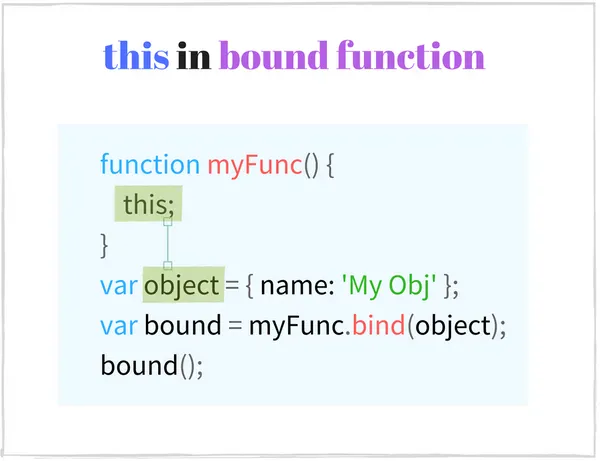
來看看,如何在如何在綁定函數設置 this
const numbers = {
array: [3, 5, 10],
getNumbers: function() {
return this.array;
}
};
const boundGetNumbers = numbers.getNumbers.bind(numbers);
boundGetNumbers(); // => [3, 5, 10]
// Extract method from object
const simpleGetNumbers = numbers.getNumbers;
simpleGetNumbers(); // => undefined (嚴格模式下報錯)numbers.getNumbers.bind(numbers)返回綁定numbers對象boundGetNumbers函數。boundGetNumbers()調用時的this是number對象,并能夠返回正確的數組對象。
可以將函數numbers.getNumbers提取到變量simpleGetNumbers中而不進行綁定。在之后的函數調用中simpleGetNumbers()的this是window(嚴格模式下為undefined),不是number對象。在這個情況下,simpleGetNumbers()不會正確返回數組。
6.2 緊密的上下文綁定
.bind()創建一個永久的上下文鏈接,并始終保持它。 一個綁定函數不能通過.call()或者.apply()來改變它的上下文,甚至是再次綁定也不會有什么作用。
只有綁定函數的構造函數調用才能更改已經綁定的上下文,但是很不推薦的做法(構造函數調用必須使用常規的非綁定函數)。
下面示例創建一個綁定函數,然后嘗試更改其已預先定義好的上下文
function getThis() {
'use strict';
return this;
}
const one = getThis.bind(1);
// 綁定函數調用
one(); // => 1
// 使用帶有.apply()和.call()的綁定函數
one.call(2); // => 1
one.apply(2); // => 1
// 再次綁定
one.bind(2)(); // => 1
// 以構造函數的形式調用綁定函數
new one(); // => Object只有new one()改變了綁定函數的上下文,其他方式的調用中this總是等于1。
7. 箭頭函數
箭頭函數用于以更短的形式聲明函數,并在詞法上綁定上下文。它可以這樣使用
const hello = (name) => {
return 'Hello ' + name;
};
hello('World'); // => 'Hello World'
// Keep only even numbers
[1, 2, 5, 6].filter(item => item % 2 === 0); // => [2, 6]箭頭函數語法簡單,沒有冗長的function 關鍵字。當箭頭函數只有一條語句時,甚至可以省略return關鍵字。
箭頭函數是匿名的,這意味著name屬性是一個空字符串''。這樣它就沒有詞法上函數名(函數名對于遞歸、分離事件處理程序非常有用)
同時,跟常規函數相反,它也不提供arguments對象。但是,這在ES6中通過rest parameters修復了:
const sumArguments = (...args) => {
console.log(typeof arguments); // => 'undefined'
return args.reduce((result, item) => result + item);
};
sumArguments.name // => ''
sumArguments(5, 5, 6); // => 167.1. 箭頭函數中的this
this 定義箭頭函數的封閉上下文
箭頭函數不會創建自己的執行上下文,而是從定義它的外部函數中獲取 this。 換句話說,箭頭函數在詞匯上綁定 this。
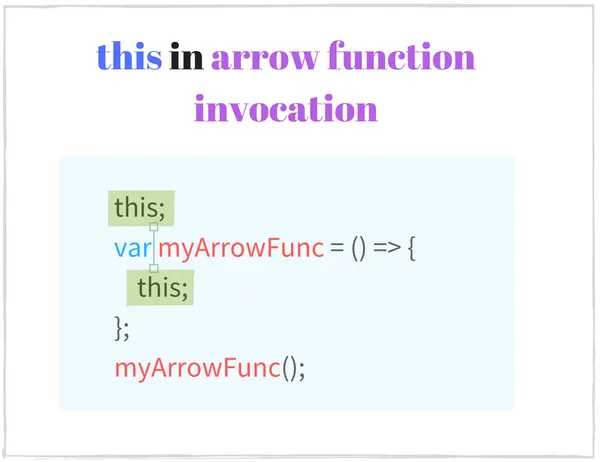
下面的例子說明了這個上下文透明的特性:
class Point {
constructor(x, y) {
this.x = x;
this.y = y;
}
log() {
console.log(this === myPoint); // => true
setTimeout(()=> {
console.log(this === myPoint); // => true
console.log(this.x + ':' + this.y); // => '95:165'
}, 1000);
}
}
const myPoint = new Point(95, 165);
myPoint.log();setTimeout使用與log()方法相同的上下文(myPoint對象)調用箭頭函數。正如所見,箭頭函數從定義它的函數繼承上下文。
如果在這個例子里嘗試用常規函數,它創建自己的上下文(window或嚴格模式下的undefined)。因此,要使相同的代碼正確地使用函數表達式,需要手動綁定上下文:setTimeout(function(){…}.bind(this))。這很冗長,使用箭頭函數是一種更簡潔、更短的解決方案。
如果箭頭函數在最頂層的作用域中定義(在任何函數之外),則上下文始終是全局對象(瀏覽器中的 window):
onst getContext = () => {
console.log(this === window); // => true
return this;
};
console.log(getContext() === window); // => true箭頭函數一勞永逸地與詞匯上下文綁定。 即使修改上下文,this也不能被改變:
const numbers = [1, 2];
(function() {
const get = () => {
console.log(this === numbers); // => true
return this;
};
console.log(this === numbers); // => true
get(); // => [1, 2]
// Use arrow function with .apply() and .call()
get.call([0]); // => [1, 2]
get.apply([0]); // => [1, 2]
// Bind
get.bind([0])(); // => [1, 2]
}).call(numbers);無論如何調用箭頭函數get,它總是保留詞匯上下文numbers。 用其他上下文的隱式調用(通過 get.call([0])或get.apply([0]))或者重新綁定(通過.bind())都不會起作用。
箭頭函數不能用作構造函數。 將它作為構造函數調用(new get())會拋出一個錯誤:TypeError: get is not a constructor。
7.2. 陷阱: 用箭頭函數定義方法
你可能希望使用箭頭函數來聲明一個對象上的方法。箭頭函數的定義相比于函數表達式短得多:(param) => {...} instead of function(param) {..}。
來看看例子,用箭頭函數在Period類上定義了format()方法:
function Period (hours, minutes) {
this.hours = hours;
this.minutes = minutes;
}
Period.prototype.format = () => {
console.log(this === window); // => true
return this.hours + ' hours and ' + this.minutes + ' minutes';
};
const walkPeriod = new Period(2, 30);
walkPeriod.format(); // => 'undefined hours and undefined minutes'由于format是一個箭頭函數,并且在全局上下文(最頂層的作用域)中定義,因此 this 指向window對象。
即使format作為方法在一個對象上被調用如walkPeriod.format(),window仍然是這次調用的上下文。之所以會這樣是因為箭頭函數有靜態的上下文,并不會隨著調用方式的改變而改變。
該方法返回'undefined hours和undefined minutes',這不是咱們想要的結果。
函數表達式解決了這個問題,因為常規函數確實能根據實際調用改變它的上下文:
function Period (hours, minutes) {
this.hours = hours;
this.minutes = minutes;
}
Period.prototype.format = function() {
console.log(this === walkPeriod); // => true
return this.hours + ' hours and ' + this.minutes + ' minutes';
};
const walkPeriod = new Period(2, 30);
walkPeriod.format(); // => '2 hours and 30 minutes'walkPeriod.format()是一個對象上的方法調用,它的上下文是walkPeriod對象。this.hours等于2,this.minutes等于30,所以這個方法返回了正確的結果:'2 hours and 30 minutes'。
原文:https://dmitripavlutin.com/gentle-explanation-of-this-in-javascript/
代碼部署后可能存在的BUG沒法實時知道,事后為了解決這些BUG,花了大量的時間進行log 調試,這邊順便給大家推薦一個好用的BUG監控工具 Fundebug。
總結
為函數調用對this影響最大,從現在開始不要問自己:
this 是從哪里來的?
而是要看看
函數是怎么被調用的?
對于箭頭函數,需要想想
在這個箭頭函數被定義的地方,this是什么?
這是處理this時的正確想法,它們可以讓你免于頭痛。
以上是“JS中this在各個場景下指向的示例分析”這篇文章的所有內容,感謝各位的閱讀!希望分享的內容對大家有幫助,更多相關知識,歡迎關注億速云行業資訊頻道!
免責聲明:本站發布的內容(圖片、視頻和文字)以原創、轉載和分享為主,文章觀點不代表本網站立場,如果涉及侵權請聯系站長郵箱:is@yisu.com進行舉報,并提供相關證據,一經查實,將立刻刪除涉嫌侵權內容。